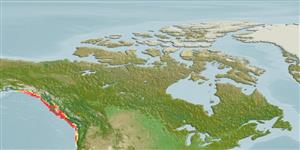>
Perciformes/Scorpaenoidei (Scorpionfishes) >
Sebastidae (Rockfishes, rockcods and thornyheads) > Sebastinae
Etymology: Sebastes: Greek, sebastes = august, venerable (Ref. 45335); reedi: Named after the research vessel named in honor of Dr. G.B. Reed, chairman of the Fisheries Research Board of Canada and educator (Ref. 6885).
Eponymy: The ‘G.B. Reed’ was a research vessel of the Canadian Department of Fisheries and Oceans. The vessel was named after Dr Guilford Bevil Reed (1887–1955), a medical researcher who became joint Chairman (1947–1953) of the Fisheries Research Board of Canada. (Ref. 128868), visit book page.
Environment: milieu / climate zone / rango de profundidad / distribution range
Ecología
marino batidemersal; rango de profundidad 137 - 375 m, usually 274 - 366 m (Ref. 27437). Deep-water; 60°N - 41°N, 145°W - 124°W
Eastern Pacific: northern Gulf of Alaska to Crescent City, northern California, USA.
Tamaño / Peso / Age
Madurez: Lm ? range ? - ? cm
Max length : 58.0 cm TL macho / no sexado; (Ref. 2850); edad máxima reportada: 99 años (Ref. 39247)
Short description
Claves de identificación | Morfología | Morfometría
Espinas dorsales (total) : 13; Radios blandos dorsales (total) : 14 - 15; Espinas anales: 3; Radios blandos anales: 7 - 8. Head spines weak - nasal, preocular, supraocular, postocular, tympanic and parietal spines present, coronal and nuchal spines absent (Ref. 27437). Lower jaw long, with moderate, wide symphyseal knob (Ref. 27437). Caudal fin moderately indented (Ref. 6885). Red with yellow to orange in color, smaller specimens mixed with black; 3 vague dark bands across head; jaws red; mouth pinkish white with yellow and black blotches; lateral line pinkish (Ref. 27437).
Body shape (shape guide): fusiform / normal.
Found on rough bottoms (Ref. 2850). Minimum depth reported from Ref. 27437. Viviparous (Ref. 34817).
Life cycle and mating behavior
Madurez | Reproducción | Puesta | Huevos | Fecundidad | Larva
Ovoviviparous (Ref. 6885).
Eschmeyer, W.N., E.S. Herald and H. Hammann, 1983. A field guide to Pacific coast fishes of North America. Boston (MA, USA): Houghton Mifflin Company. xii+336 p. (Ref. 2850)
IUCN Red List Status (Ref. 130435: Version 2025-1)
Threat to humans
Harmless
Human uses
Pesquerías: comercial
Herramientas
Special reports
Download XML
Fuentes de Internet
Estimates based on models
Preferred temperature (Referencia
123201): 4.7 - 6.4, mean 5.9 °C (based on 5 cells).
Phylogenetic diversity index (Referencia
82804): PD
50 = 0.5000 [Uniqueness, from 0.5 = low to 2.0 = high].
Bayesian length-weight: a=0.01000 (0.00495 - 0.02022), b=3.09 (2.92 - 3.26), in cm total length, based on LWR estimates for this Genus-body shape (Ref.
93245).
Nivel trófico (Referencia
69278): 3.9 ±0.66 se; based on food items.
Resiliencia (Referencia
120179): Bajo, población duplicada en un tiempo mínimo de 4.5-14 años (K=0.12-0.13; tmax=99).
Fishing Vulnerability (Ref.
59153): High vulnerability (63 of 100).
🛈
